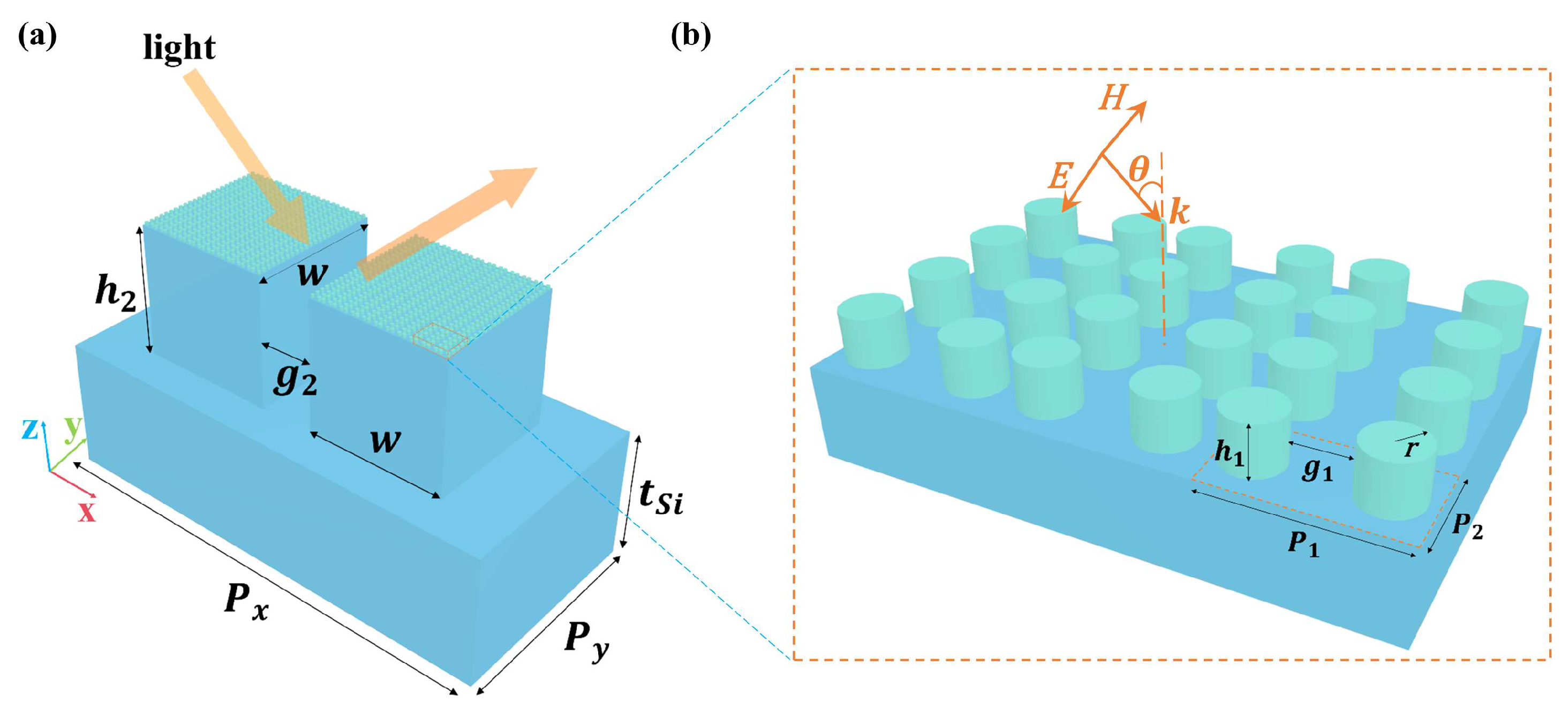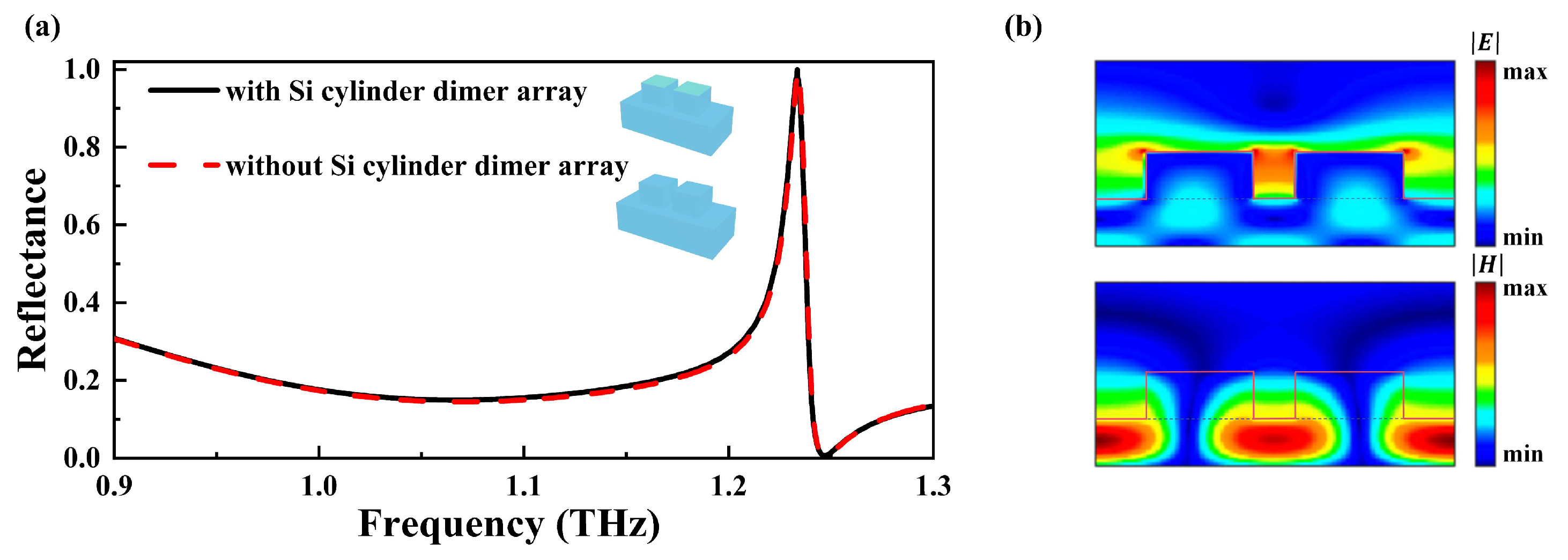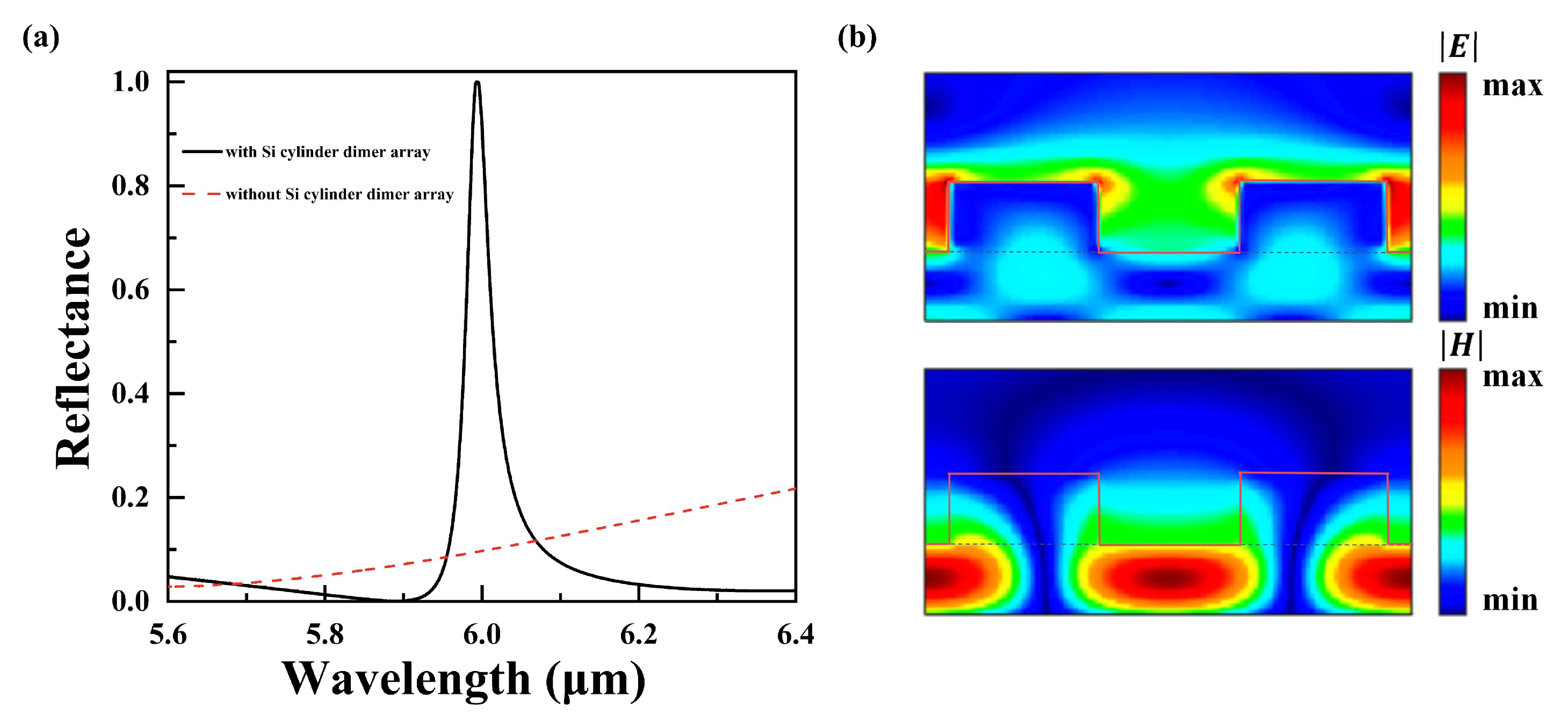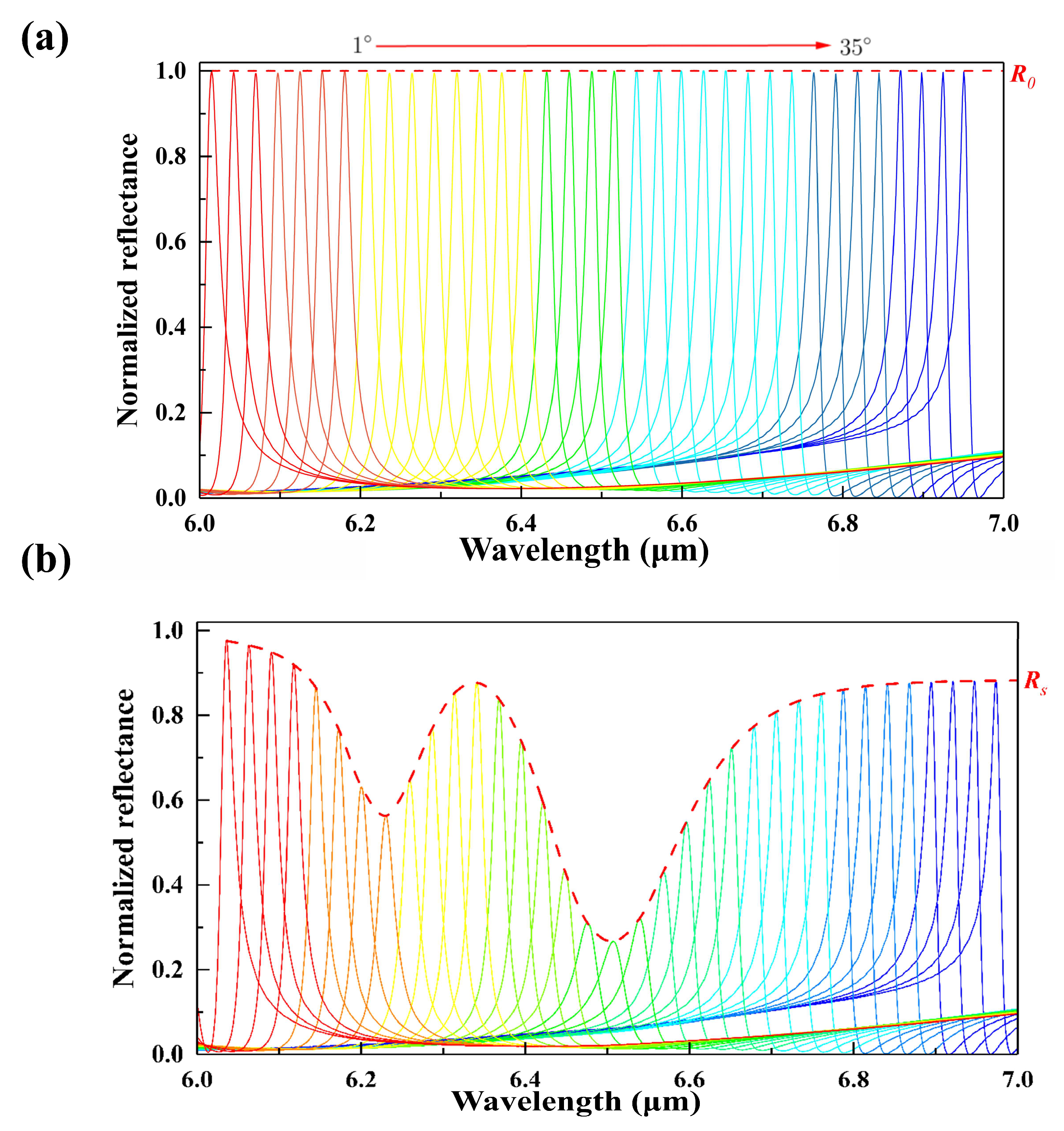Enhancing Multi-Spectral Fingerprint Sensing for Trace Explosive Molecules with All-Silicon Metasurfaces
Abstract
:1. Introduction
2. Design and Simulation Method
3. Results and Discussion
3.1. Fingerprint Detection in the THz Region
3.2. Fingerprint Identification in the Mid-IR Region
4. Conclusions
Author Contributions
Funding
Data Availability Statement
Conflicts of Interest
References
- Stuart, B.H. Infrared Spectroscopy: Fundamentals and Applications; John Wiley & Sons: Hoboken, NJ, USA, 2004. [Google Scholar]
- Joyce, B.S.; Lionel, C.; Patrick, M.; Bruno, B. Chemometrics Applied to Quantitative Analysis of Ternary Mixtures by Terahertz Spectroscopy. Anal. Chem. 2014, 86, 4927–4933. [Google Scholar]
- Walther, M.; Plochocka, P.; Fischer, B.; Helm, H.; Jepsen, P. Collective vibrational modes in biological molecules investigated by terahertz time-domain spectroscopy. Biopolym. Orig. Res. Biomol. 2002, 67, 310–313. [Google Scholar] [CrossRef] [PubMed]
- Xiong, W.; Shen, J. Fingerprint extraction from interference destruction terahertz spectrum. Opt. Express 2010, 18, 21798–21803. [Google Scholar] [CrossRef] [PubMed]
- Liu, P.; Li, W.; Chen, N.; Ma, C.; Li, X.; Yan, D. Enhancing the terahertz absorption spectrum based on the low refractive index all-dielectric metasurface. Photonics 2022, 9, 848. [Google Scholar] [CrossRef]
- Yan, D.-X.; Wang, Z.-H.; Li, X.-J.; Zhang, L.; Zhou, W.-D.; Li, J.-N. Highly boosted trace-amount terahertz vibrational absorption spectroscopy based on defect one-dimensional photonic crystal. Opt. Lett. 2023, 48, 1654–1657. [Google Scholar] [CrossRef] [PubMed]
- Liu, X.; Chen, W.; Ma, Y.; Xie, Y.; Zhou, J.; Zhu, L.; Xu, Y.; Zhu, J. Enhancing THz fingerprint detection on the planar surface of an inverted dielectric metagrating. Photonics Res. 2022, 10, 2836–2845. [Google Scholar] [CrossRef]
- Xu, W.; Xie, L.; Ying, Y. Mechanisms and applications of terahertz metamaterial sensing: A review. Nanoscale 2017, 9, 13864–13878. [Google Scholar] [CrossRef]
- Sun, L.; Xu, L.; Wang, J.; Jiao, Y.; Ma, Z.; Ma, Z.; Chang, C.; Yang, X.; Wang, R. A pixelated frequency-agile metasurface for broadband terahertz molecular fingerprint sensing. Nanoscale 2022, 14, 9681–9685. [Google Scholar] [CrossRef] [PubMed]
- Zhong, Y.; Du, L.; Liu, Q.; Zhu, L.; Meng, K.; Zou, Y.; Zhang, B. Ultrasensitive specific sensor based on all-dielectric metasurfaces in the terahertz range. RSC Adv. 2020, 10, 33018–33025. [Google Scholar] [CrossRef] [PubMed]
- Li, X.-J.; Ma, C.; Yan, D.-X.; Guo, S.-H.; Zhang, L.; Yang, J.; Zhao, Y.; Zhou, W.-D. Enhanced trace-amount terahertz vibrational absorption spectroscopy using surface spoof polarization in metasurface structures. Opt. Lett. 2022, 47, 2446–2449. [Google Scholar] [CrossRef]
- Lee, S.-H.; Lee, D.; Choi, M.H.; Son, J.-H.; Seo, M. Highly sensitive and selective detection of steroid hormones using terahertz molecule-specific sensors. Anal. Chem. 2019, 91, 6844–6849. [Google Scholar] [CrossRef] [PubMed]
- Qin, J.; Cheng, W.; Han, B.; Du, Y.; Han, Z.; Zhao, Z. Ultrasensitive detection of saccharides using terahertz sensor based on metallic nano-slits. Sci. Rep. 2020, 10, 3712. [Google Scholar] [CrossRef] [PubMed]
- Meng, K.; Park, S.; Burnett, A.; Gill, T.; Wood, C.; Rosamond, M.; Li, L.; Chen, L.; Bacon, D.; Freeman, J. Increasing the sensitivity of terahertz split ring resonator metamaterials for dielectric sensing by localized substrate etching. Opt. Express 2019, 27, 23164–23172. [Google Scholar] [CrossRef]
- Yan, D.; Li, X.; Ma, C.; Qiu, G.; Cao, M.; Li, J.; Guo, S. Terahertz refractive index sensing based on gradient metasurface coupled confined spoof surface plasmon polaritons mode. IEEE Sens. J. 2021, 22, 324–329. [Google Scholar] [CrossRef]
- Li, Z.; Cheng, Y.; Luo, H.; Chen, F.; Li, X. Dual-band tunable terahertz perfect absorber based on all-dielectric InSb resonator structure for sensing application. J. Alloys Compd. 2022, 925, 166617. [Google Scholar] [CrossRef]
- Cerjan, B.; Yang, X.; Nordlander, P.; Halas, N.J. Asymmetric aluminum antennas for self-calibrating surface-enhanced infrared absorption spectroscopy. ACS Photonics 2016, 3, 354–360. [Google Scholar] [CrossRef]
- Lee, D.-K.; Kang, J.-H.; Lee, J.-S.; Kim, H.-S.; Kim, C.; Hun Kim, J.; Lee, T.; Son, J.-H.; Park, Q.-H.; Seo, M. Highly sensitive and selective sugar detection by terahertz nano-antennas. Sci. Rep. 2015, 5, 15459. [Google Scholar] [CrossRef] [PubMed]
- Neubrech, F.; Huck, C.; Weber, K.; Pucci, A.; Giessen, H. Surface-enhanced infrared spectroscopy using resonant nanoantennas. Chem. Rev. 2017, 117, 5110–5145. [Google Scholar] [CrossRef]
- Yang, J.; Francescato, Y.; Chen, D.; Yang, J.; Huang, M. Broadband molecular sensing with a tapered spoof plasmon waveguide. Opt. Express 2015, 23, 8583–8589. [Google Scholar] [CrossRef]
- Badri, S.H. Transmission resonances in silicon subwavelength grating slot waveguide with functional host material for sensing applications. Opt. Laser Technol. 2021, 136, 106776. [Google Scholar] [CrossRef]
- Tognazzi, A.; Rocco, D.; Gandolfi, M.; Locatelli, A.; Carletti, L.; De Angelis, C. High quality factor silicon membrane metasurface for intensity-based refractive index sensing. Optics 2021, 2, 193–199. [Google Scholar] [CrossRef]
- Silalahi, H.M.; Chen, Y.-P.; Shih, Y.-H.; Chen, Y.-S.; Lin, X.-Y.; Liu, J.-H.; Huang, C.-Y. Floating terahertz metamaterials with extremely large refractive index sensitivities. Photonics Res. 2021, 9, 1970–1978. [Google Scholar] [CrossRef]
- Fang, W.; Ma, Z.; Lv, X.; Liu, J.; Pei, W.; Geng, Z. Flexible terahertz metamaterial biosensor for label-free sensing of serum tumor marker modified on a non-metal area. Opt. Express 2022, 30, 16630–16643. [Google Scholar] [CrossRef] [PubMed]
- Zhang, J.; Mu, N.; Liu, L.; Xie, J.; Feng, H.; Yao, J.; Chen, T.; Zhu, W. Highly sensitive detection of malignant glioma cells using metamaterial-inspired THz biosensor based on electromagnetically induced transparency. Biosens. Bioelectron. 2021, 185, 113241. [Google Scholar] [CrossRef] [PubMed]
- Tittl, A.; Leitis, A.; Liu, M.; Yesilkoy, F.; Choi, D.-Y.; Neshev, D.N.; Kivshar, Y.S.; Altug, H. Imaging-based molecular barcoding with pixelated dielectric metasurfaces. Science 2018, 360, 1105–1109. [Google Scholar] [CrossRef] [PubMed]
- Leitis, A.; Tittl, A.; Liu, M.; Lee, B.H.; Gu, M.B.; Kivshar, Y.S.; Altug, H. Angle-multiplexed all-dielectric metasurfaces for broadband molecular fingerprint retrieval. Sci. Adv. 2019, 5, eaaw2871. [Google Scholar] [CrossRef] [PubMed]
- Badri, S.H.; Gilarlue, M.; SaeidNahaei, S.; Kim, J.S. High-Q Fano resonance in all-dielectric metasurfaces for molecular fingerprint detection. JOSA B 2022, 39, 563–569. [Google Scholar] [CrossRef]
- Zhang, X.; Liu, J.; Qin, J. A terahertz metasurface sensor with fingerprint enhancement in a wide spectrum band for thin film detection. Nanoscale Adv. 2023, 5, 2210–2215. [Google Scholar] [CrossRef] [PubMed]
- Zhu, J.; Jiang, S.; Xie, Y.; Li, F.; Du, L.; Meng, K.; Zhu, L.; Zhou, J. Enhancing terahertz molecular fingerprint detection by a dielectric metagrating. Opt. Lett. 2020, 45, 2335–2338. [Google Scholar] [CrossRef] [PubMed]
- Xie, Y.; Liu, X.; Li, F.; Zhu, J.; Feng, N. Ultra-wideband enhancement on mid-infrared fingerprint sensing for 2D materials and analytes of monolayers by a metagrating. Nanophotonics 2020, 9, 2927–2935. [Google Scholar] [CrossRef]
- McCrindle, I.J.; Grant, J.; Drysdale, T.D.; Cumming, D.R. Multi-spectral materials: Hybridisation of optical plasmonic filters and a terahertz metamaterial absorber. Adv. Opt. Mater. 2014, 2, 149–153. [Google Scholar] [CrossRef]
- Manjunath, S.; Liu, M.; Raj, V.; Aoni, R.A.; Powell, D.A.; Shadrivov, I.V.; Rahmani, M. Dual-Region Resonant Meander Metamaterial. Adv. Opt. Mater. 2020, 8, 1901658. [Google Scholar] [CrossRef]
- McCrindle, I.J.H.; Grant, J.P.; Gouveia, L.C.P.; Cumming, D.R.S. Infrared plasmonic filters integrated with an optical and terahertz multi-spectral material. Phys. Status Solidi A 2015, 212, 1625–1633. [Google Scholar] [CrossRef]
- Brown, E.; Bjarnason, J.; Fedor, A.; Korter, T. On the strong and narrow absorption signature in lactose at 0.53 THz. Appl. Phys. Lett. 2007, 90, 061908. [Google Scholar] [CrossRef]
- Yokosuk, M.O.; Tiwald, T.E.; Saunders, D.L.; Blake, T.A.; Myers, T.L. Combining spectroscopic techniques to determine the optical constants of powdered lactose. Appl. Opt. 2021, 60, 2412–2421. [Google Scholar] [CrossRef] [PubMed]
- Leahy-Hoppa, M.; Fitch, M.; Zheng, X.; Hayden, L.; Osiander, R. Wideband terahertz spectroscopy of explosives. Chem. Phys. Lett. 2007, 434, 227–230. [Google Scholar] [CrossRef]
- Fabas, A.; El Ouazzani, H.; Hugonin, J.-P.; Dupuis, C.; Haidar, R.; Greffet, J.-J.; Bouchon, P. Dispersion-based intertwined SEIRA and SPR effect detection of 2, 4-dinitrotoluene using a plasmonic metasurface. Opt. Express 2020, 28, 39595–39605. [Google Scholar] [CrossRef] [PubMed]
- Tao, J.; Cuan, Q.; Halpegamage, S.; Addou, R.; Gong, X.-Q.; Batzill, M. Combined surface science and DFT study of the adsorption of dinitrotoluene (2,4-DNT) on rutile TiO2 (110): Molecular scale insight into sensing of explosives. J. Phys. Chem. C 2013, 117, 16468–16476. [Google Scholar] [CrossRef]
- Federici, J.F.; Schulkin, B.; Huang, F.; Gary, D.; Barat, R.; Oliveira, F.; Zimdars, D. THz imaging and sensing for security applications—Explosives, weapons and drugs. Semicond. Sci. Technol. 2005, 20, S266. [Google Scholar] [CrossRef]
- Bi, K.; Wang, Q.; Xu, J.; Chen, L.; Lan, C.; Lei, M. All-dielectric metamaterial fabrication techniques. Adv. Opt. Mater. 2021, 9, 2001474. [Google Scholar] [CrossRef]
- Chen, X.; Zhang, Y.; Cai, G.; Zhuo, J.; Lai, K.; Ye, L. All-dielectric metasurfaces with high Q-factor Fano resonances enabling multi-scenario sensing. Nanophotonics 2022, 11, 4537–4549. [Google Scholar] [CrossRef]
- Wang, S.; Magnusson, R. Theory and applications of guided-mode resonance filters. Appl. Opt. 1993, 32, 2606–2613. [Google Scholar] [CrossRef] [PubMed]
- Han, S.; Rybin, M.V.; Pitchappa, P.; Srivastava, Y.K.; Kivshar, Y.S.; Singh, R. Guided-Mode Resonances in All-Dielectric Terahertz Metasurfaces. Adv. Opt. Mater. 2020, 8, 1900959. [Google Scholar] [CrossRef]
- Rosenblatt, D.; Sharon, A.; Friesem, A.A. Resonant grating waveguide structures. IEEE J. Quantum Electron. 1997, 33, 2038–2059. [Google Scholar] [CrossRef]
- Hu, Y.; Huang, P.; Guo, L.; Wang, X.; Zhang, C. Terahertz spectroscopic investigations of explosives. Phys. Lett. A 2006, 359, 728–732. [Google Scholar] [CrossRef]
- Duvillaret, L.; Garet, F.; Coutaz, J.-L. Highly precise determination of optical constants and sample thickness in terahertz time-domain spectroscopy. Appl. Opt. 1999, 38, 409–415. [Google Scholar] [CrossRef] [PubMed]
- Dorney, T.D.; Baraniuk, R.G.; Mittleman, D.M. Material parameter estimation with terahertz time-domain spectroscopy. JOSA A 2001, 18, 1562–1571. [Google Scholar] [CrossRef]
- Ramos, C.M.; Alzate, L.F.; Hernández, N.M.; Hernández, S.P.; Mina, N. Density functional theory treatment of the structures and vibrational frequencies of 2, 4-and 2, 6-dinitrotoluenes. J. Mol. Struct. THEOCHEM 2006, 769, 69–76. [Google Scholar] [CrossRef]







| 1 | 1610 | 6.21 | 15 | 1.68 × 10−3 |
| 2 | 1603 | 6.24 | 15 | 7.8 × 10−4 |
| 3 | 1538 | 6.50 | 22 | 7.4 × 10−3 |
| 4 | 1522 | 6.57 | 23 | 3.1 × 10−3 |
| Ref. | Material of Structured Layer | Analyte | Multiplexed Scheme | Working Range | Peak Enhancement Time |
|---|---|---|---|---|---|
| [26] | Silicon | Protein A/G | Geometry | Mid-IR | ~60 |
| [27] | Germanium | PMMA | Angle | Mid-IR | ~50 |
| [30] | PE | α-lactose | Angle | THz | ~25 |
| [5] | ABS | α-lactose | Angle | THz | ~45 |
| This work | Silicon | 2,4-DNT | Angle | Mid-IR/THz | ~55/~64 |
Disclaimer/Publisher’s Note: The statements, opinions and data contained in all publications are solely those of the individual author(s) and contributor(s) and not of MDPI and/or the editor(s). MDPI and/or the editor(s) disclaim responsibility for any injury to people or property resulting from any ideas, methods, instructions or products referred to in the content. |
© 2024 by the authors. Licensee MDPI, Basel, Switzerland. This article is an open access article distributed under the terms and conditions of the Creative Commons Attribution (CC BY) license (https://creativecommons.org/licenses/by/4.0/).
Share and Cite
Lin, J.; Xue, Y.; Wang, W.; Sun, M.; Shi, S.; Zhang, S.; Shi, Y. Enhancing Multi-Spectral Fingerprint Sensing for Trace Explosive Molecules with All-Silicon Metasurfaces. Nanomaterials 2024, 14, 738. https://doi.org/10.3390/nano14090738
Lin J, Xue Y, Wang W, Sun M, Shi S, Zhang S, Shi Y. Enhancing Multi-Spectral Fingerprint Sensing for Trace Explosive Molecules with All-Silicon Metasurfaces. Nanomaterials. 2024; 14(9):738. https://doi.org/10.3390/nano14090738
Chicago/Turabian StyleLin, Jie, Ying Xue, Weijin Wang, Mingjun Sun, Shengnan Shi, Shan Zhang, and Yanpeng Shi. 2024. "Enhancing Multi-Spectral Fingerprint Sensing for Trace Explosive Molecules with All-Silicon Metasurfaces" Nanomaterials 14, no. 9: 738. https://doi.org/10.3390/nano14090738





